Do leaves need chlorophyll for growth? Teach article
When next teaching photosynthesis, try these simple experiments with variegated plants.
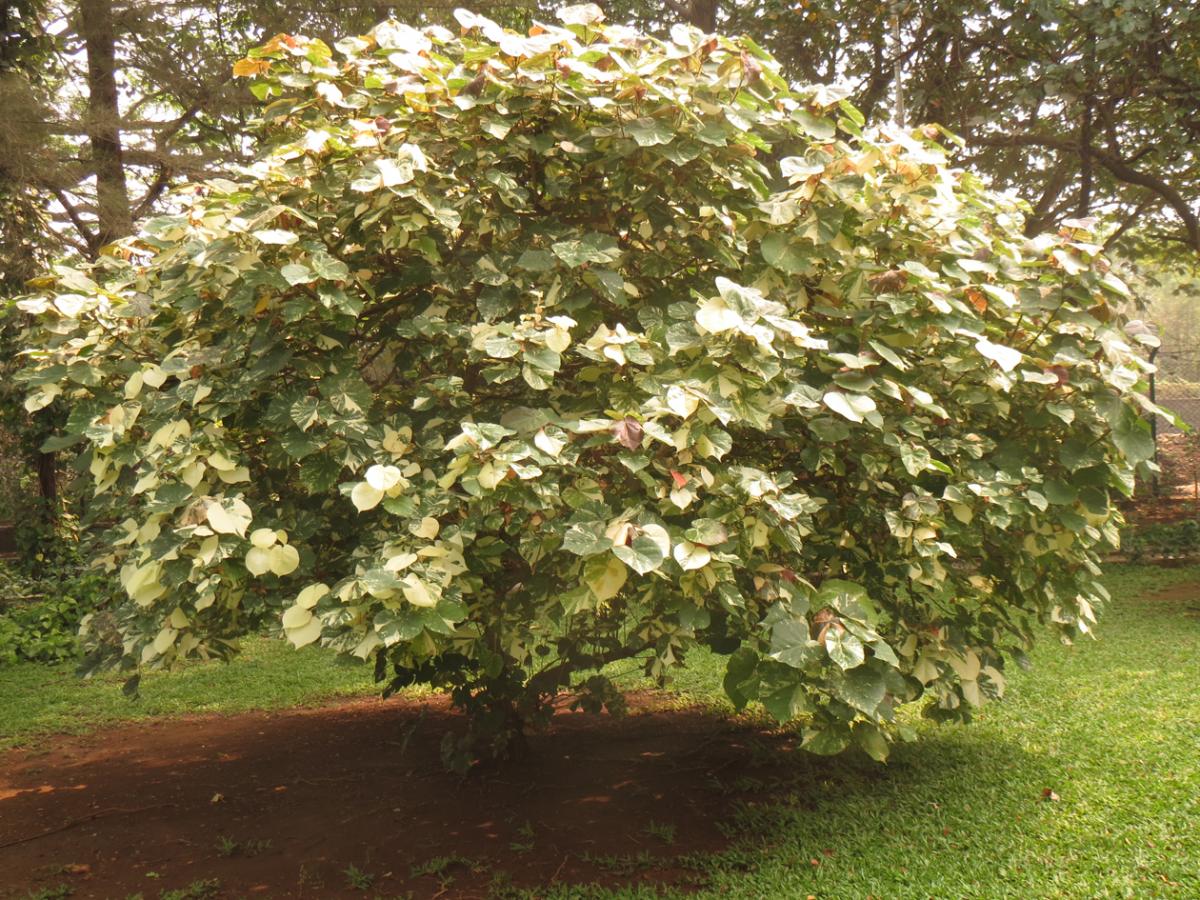
Talipariti tiliaceum
Image courtesy of Gurinder
Singh
Are your students familiar with the following statements?
- Plants make their food by photosynthesis.
- Leaves are green because they contain a green pigment (chlorophyll).
- Photosynthesis cannot occur without chlorophyll.
If students believe these statements, then what will they think when they see a white leaf? They may be confused and wonder how a white leaf – which does not appear to have chlorophyll – can make its own food. They may ask, “How does a white leaf survive?”
Here, we describe some simple ways of using variegated plants (e.g. variegated bhendi, Talipariti tiliaceum) to investigate the relationship between the presence of green pigment, food production and leaf growth.
While investigating these relationships, we might make two hypotheses. One is that the white leaves will be stunted because they contain less chlorophyll, which is needed for photosynthesis to occur. An alternative hypothesis is that the white leaves, or the white parts of leaves, will not be stunted because the leaves still contain a dense network of veins that can carry food from one part of the leaf to another, or from green leaves to white leaves.
The following activities provide different ways for these two hypotheses to be investigated. The activities arose from a research project to investigate how school students learn science when they ask their own questions and try to answer them by planning and doing their own investigations. We initially designed experiments based on questions that we thought students might ask when presented with a variegated bhendi. Next, we interacted informally with some students to see what questions they actually asked. We then organised a three-day workshop for students aged 11–13, during which they carried out some of the activities that we had devised and also investigated some of their own questions (including “Are white leaves thinner?” and “Do white leaves wilt faster?”).
Some of the activities take no more than half an hour; other investigations can run over several days or months. They all require no more than basic school equipment and are aimed at students aged between nine and 14; in some cases they can be adapted to students as old as 19.
Are white leaves smaller than green leaves?
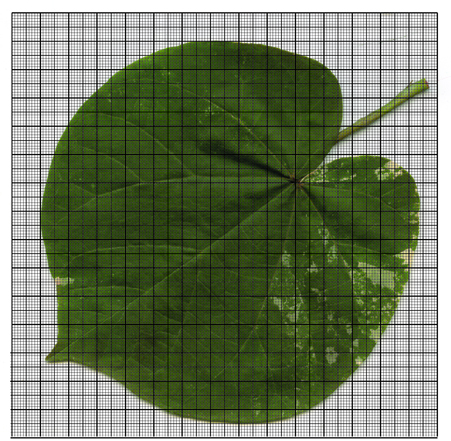
piece of graph paper helps
measure the area
Image courtesy of Karen
Haydock
Suitable for students aged 9–14, this activity is a good way to integrate science and mathematics as it motivates students to learn how to measure the surface area of odd-shaped objects.
- Take representative samples of white and green leaves.
- Measure and record the size of each of the leaves.
- Compare the measurements of the white and green leaves.
Allow your students to suggest their own methods to determine the size of the leaves – these might include comparing sizes by placing one leaf over another or using graph paper to measure the surface areas (figure 1).
We found that the answer may be biased if an inadequate sampling method is used. Young students sometimes do not understand that finding just one white leaf that is smaller than one green leaf is not adequate evidence to make a generalisation. If all the students in a class make measurements and there is variation in the results, then the students may confront the contradictions they find. Even then, some students may disregard incongruent evidence, thinking that it is ‘wrong’. This could be an appropriate occasion to discuss elementary statistics and probability. Students could discuss what kind of sampling would be ‘fair’: for example, purposely choosing leaves of certain sizes, picking all or a certain number of the leaves from one branch, or using a particular number of leaves.
A truly meaningful investigation would require fairly sophisticated statistics, more suitable for older students (aged 16–19).
Is the white half of a leaf smaller than the green half?
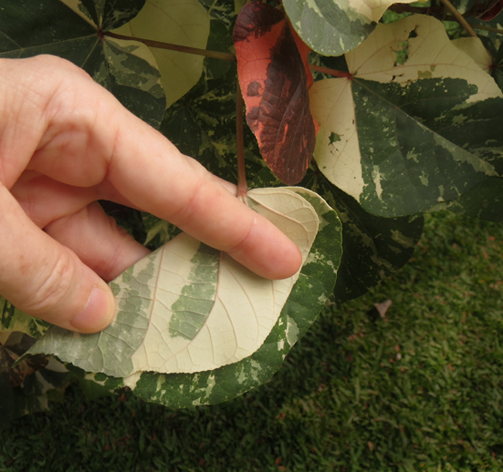
find out whether the mostly
green side is larger than the
mostly white side
Image courtesy of Karen
Haydock
Some leaves have one side that is noticeably whiter than the other side. If the shortage of green pigment causes stunted growth, we might expect the whiter side to be smaller. This question can be answered without even plucking the leaves but by gently folding each leaf in half along the midrib and observing which side is larger (figure 2). This is an easy activity, even for students as young as 9.
We tested dozens of variegated bhendi leaves, and could not find a single leaf in which the half that clearly contained more white was as large as the half that contained more green, suggesting that the white parts of leaves do have stunted growth.
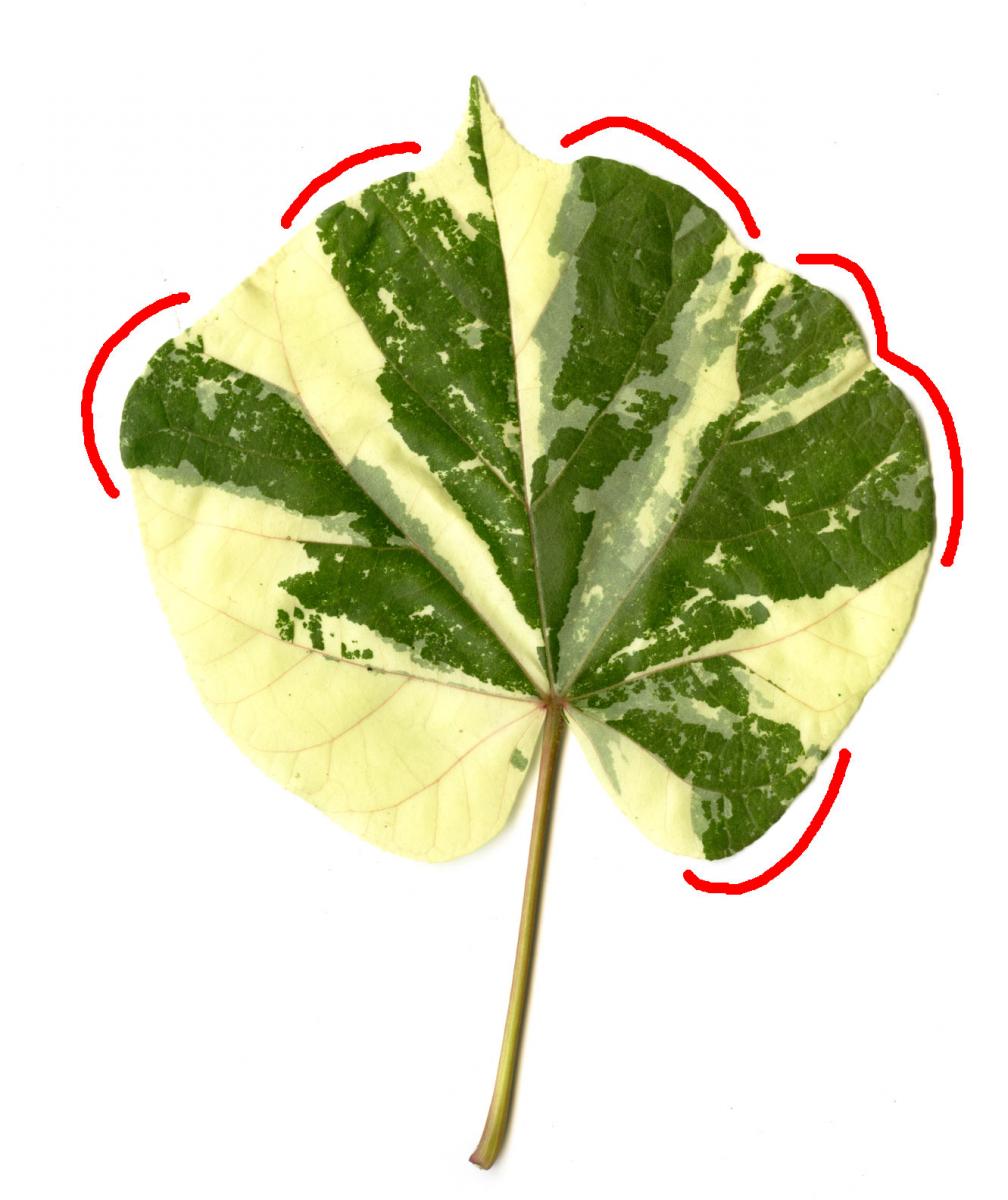
bhendi leaf correspond to
greener areas
Image courtesy of Karen
Haydock
We also noticed that bulges on the margins of variegated leaves corresponded to green areas (figure 3). This supports the conclusion that the intervening white areas have stunted growth. It would be interesting to see whether these observations hold for other variegated plants.
Do white leaves weigh less than green leaves?
If white leaves produce less food, we might expect them to weigh less.
- Find and pick white and green leaves of the same size. (This is not easy.)
- Using an electronic balance, record the weight of each leaf.
- Dry the leaves and then record their weights again. Make sure that you know which leaf is which.
To our surprise, we found that some fresh green leaves weighed considerably less than white leaves of the same size. However, after the leaves had been dried, the white ones usually weighed less than the green ones. This indicates that the white leaves initially contained more water, but that the green leaves had more bulk (dry weight). Apparently the white leaves had produced – or at least stored – less food.
Are white leaves thinner than green leaves?
White leaves might be expected to be thinner than green leaves.
- Pick pairs of white and green leaves of similar size.
- With eyes closed, one student should be presented with a pair of leaves (figure 4). Which leaf feels thicker – white or green?
- Repeat until all the pairs of leaves have been tested.
- Each pair of leaves could be tested by a different student. Alternatively, you could also investigate the objectivity of the method by having each pair of leaves tested by several students.
We concluded that the white leaves are generally thinner than the green leaves, perhaps because they are not able to make enough food and they do not get enough food from other leaves.
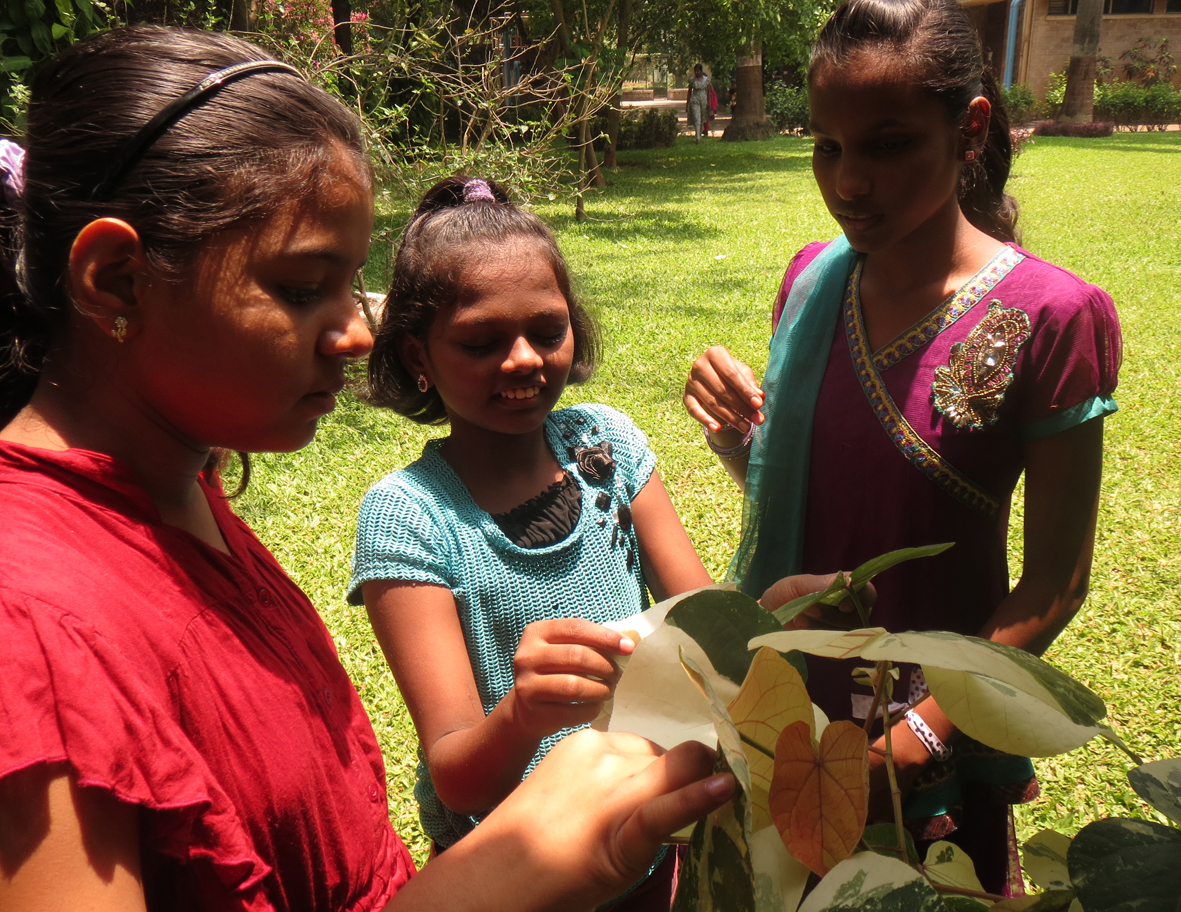
Image courtesy of Karen Haydock
Do white leaves wilt faster than green leaves?
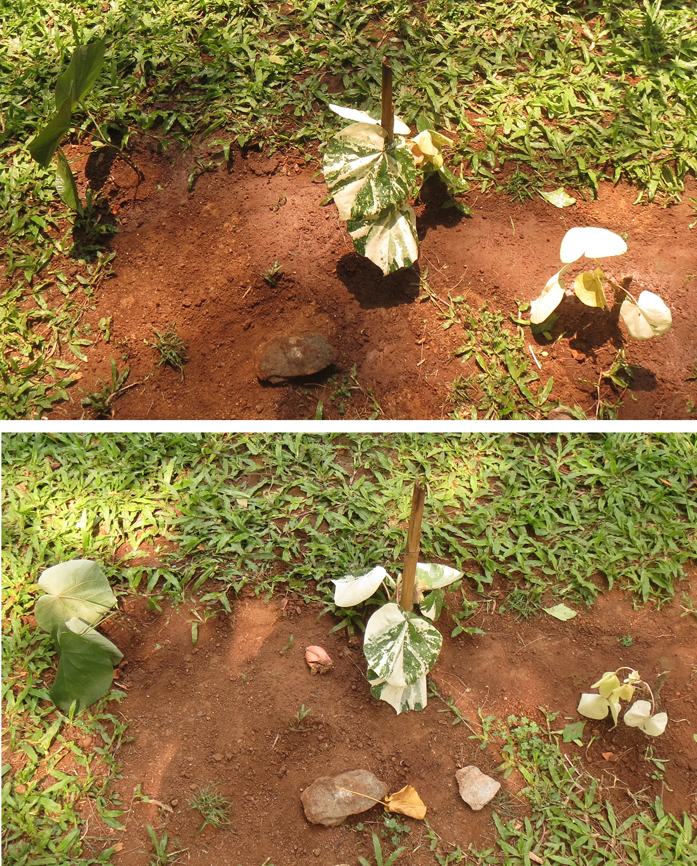
of white, green, or mixed
white nd green leaves placed
in soil overnight
Image courtesy of Karen
Haydock
If white leaves rely on food provided by green leaves, white leaves might be expected to survive less well once removed from the plant.
- Cut one branch that has only green leaves, one that has only white leaves, and one that has both green and white leaves.
- Place the three branches in bottles of water and leave them overnight.
- Optional: replicate steps 1 and 2 using warm water for one set of three branches and cold water for another three.
- Optional: cut three additional branches and leave them in watered soil overnight
- How do the leaves on the different branches compare the next day?
We found that the branches of white leaves were much less turgid than the branches of green leaves, while the branches of both white and green leaves were somewhere in between, confirming our prediction.
Our conclusions
Overall, our conclusion was that the white areas of variegated bhendi leaves do have stunted growth. Although the white leaves clearly receive food from the green leaves via the plant’s transport system, this is apparently not sufficient to compensate for their reduced photosynthetic abilities.
How then do variegated plants survive? The simple answer is probably that we humans maintain them artificially. Can your students find any examples of variegated plants existing in the wild?
Now it’s your turn
We hope this article inspires you to try these and similar activities. For example, what other questions could your students explore using bhendi or other variegated plants?
We would be interested to hear how you adapt them to your teaching environment and to learn about other experiments you might have performed using variegated plants at school. Please leave your comments below.
Alternatives to bhendi
We used a variegated variant of T. tiliaceum, a plant that is frequently grown here in Maharashtra, India, and is commonly known in Marathi as bhendi (not to be confused with the vegetable bhendi or okra, the flowers of which are similar, hence the name). There are, however, many other variegated varieties of ornamental plants that can be used.
- Variegated gingko (Gingko biloba variegatum)
- Variegated maples (e.g. Acer davidii Hansu suru or Acer platanoides variegatum)
- Aralia elata ‘Aureovariegata’
- Clown fig (Ficus aspera)
- Some varieties of Caladium
- Some varieties of Dracaena
- Some species of Hosta.
We obtained slightly different results when we investigated different species. This makes our conclusions all the more interesting: perhaps not all variegated leaves have obviously stunted growth in white areas?
Resources
- For more information on variegated leaves, see the general botany section of the website of the Mildred E Mathias Botanical Garden, based at University of California, Los Angeles, USA.
- You can also find out more about variegated plants on the Union County College website.
- There is also an online library of images of variegated plant leaves.
Review
This article suggests many practical activities that can be used to teach how photosynthesis works. Not only will the students gain a deeper understanding of photosynthesis, the measurements and calculations involved in some of the experiments could be used to integrate science and mathematics. The article could also be used as a starting point to explain the scientific method and how scientists work.
Mireia Güell, Spain





